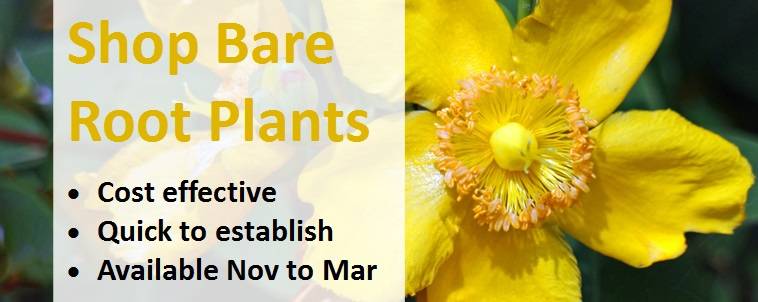What are bare root plants?
Bare root plants are plants which have been nurtured on the nursery in the open ground and are supplied with no soil around the roots. This compares to containerised plants which are supplied with compost around the roots in plastic pots and root balled plants grown in the open ground and dug up with soil around the roots, secured with burlap. In contrast, when bare root plants are dug the soil around their roots is carefully knocked away to reveal the bare roots and shipped in this way (hence the name "bare root").

Bare root box plants (Buxus Sempervirens)
Bare root plants are available during the dormancy period between November and March. When shipping, we lock in moisture around the roots of your bare root plants as part of our packaging process to ensure they arrive looking ship shaped and don't dry out in transit. They are better value for money than their containerised counter-parts because they are cheaper to grow. Many people find bare root plants are a great way to get more "bang for your buck", providing you don't mind venturing out into the garden during the winter to plant them.

There are some other advantages to choosing bare root plants:
1) They are quicker to establish as the roots are in direct contact with the soil. In comparison, a large portion of the roots of containerised plants are surrounded by compost. For bare root plants, we recommend sprinkling some mycorrhizal fungi around the roots immediately before planting. The plant has a mutually beneficial relationship with the fungi which allows it to establish more quickly.
2) Bare root plants are environmentally friendly as they are grown and supplied in less plastic.

The roots of a bare root Cornus coming into direct contact with the soil
You should be aware that deciduous plants supplied bare root during the dormancy period will not have any leaves at this time, so the top growth will just be brown and twiggy to start with. That said, you'll be able to tell they have an extensive root system which will quietly establish below ground during the winter, ready to support a fabulous display of flowers and foliage when spring comes around.
Both containerised and bare root plants should be planted when the ground is not frozen or waterlogged and when it's not excessively windy. High winds will dry out the roots of bare root plants very quickly (we recommend keeping the roots in a bag whilst you prepare the ground to prevent drying out) and make it more difficult to keep taller and top heavy plants straight when backfilling. Trees in particular are vulnerable to 'wind rock' after planting which opens up grooves in the soil into which rainwater can collect and freeze, which is damaging for the newly planted roots.

Comparison of bare root and containerised laurel plants
Bare Root vs. Containerised Plants - comparison table
| Bare Root Plants | Containerised Plants | |
| Availability | Between November and March |
All year round |
| Supply | No soil around the roots | In plastic pots |
| Cost | Better value for money | Reflects cost of growing plants in pots |
| Speed of Establishment | Quicker - roots in direct contact with soil | Instant impact - deciduous plants in leaf |
| Environmentally friendly? | Yes - do not require plastic pots | Re-use of pots encouraged* |
* We offer a plastic pot recycling service at our Staffordshire garden centre.
Share this page:


